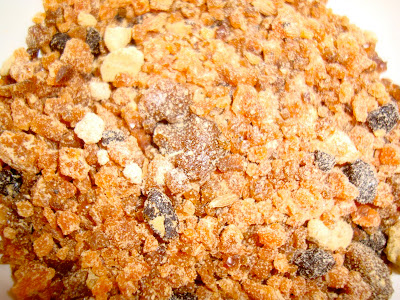Asafoetida Spice - Heeng or Hing (हिङ्ग - हींग)
Asafetida Is the Spice That Makes Food Tasty
Also called hingu (Sanskrit) or devil's dung, asafoetida is used extensively in Nepali cooking to flavor and preserve food, as well as for its medicinal properties. Asafoetida comes from an herbaceous fennel-like perennial plant. When mature, the stems are cut close to the roots releasing a milky substance that solidifies into brownish, gummy mass.
Asafoetida is sometimes described as having an unpleasant and over powering smell, due in part to the presence of sulfur. In Nepal, there is a saying, "hing ne bhai pani hing ko taalo cha" ("even if the asafoetida is used up, its aroma lingers in the wrapping cloth"). However when used with discretion, this spice mellows and adds a pleasant aroma to prepared food. The flavor of asafoetida is definitely an acquired taste, although some people describe it as similar to shallots or garlic.
 |
| (L) powdered form and (R) roughly ground asafoetida |
 |
| The solid piece of asafoetida are brown in color and come in irregular shapes. Some people prefer to buy the solid form because its flavor is more concentrated. |
When my friends and family were testing the recipes for my upcoming cookbook, Indian-ish, the foremost common source of confusion wasn't over any instruction or technique, it had been regarding an ingredient: asafoetida (also in Hindi, heeng or hing).
People couldn’t pronounce it. They couldn’t find it in Whole Foods. They were alarmed by its potent smell. But once they did use it, they immediately got it.
Asafoetida (pronounced phonetically, found online or at Indian grocers like Kalustyan’s) is that the most simultaneously misunderstood and stylish ingredient in Indian cuisine. it's essentially a gum extracted from a ferula, an herb within the celery family. it's usually available as a rough yellow powder and smells like boiled eggs. But don’t be postpone by the pungency. When used properly, a pinch of asafoetida supercharges every other spice within the pan, like salt but during a funkier way (and with none sodium). I don’t skills else to place it except to mention that to me, it makes Indian food taste more Indian.
Unlike turmeric or cumin seeds, asafoetida hasn’t yet made it into mainstream food stores. But you'll find it at the most Indian grocers in small plastic containers for around $4. My family’s go-to brand is Vandevi from India. Its signature bright yellow container has an armor-clad deity on the label and a slide-to-open cap. you'll find it on Amazon for around $8.
Asafoetida was involved in about 90 percent of the dishes of my childhood. it had been within the rich tadka (or tempered spices) for my mom’s dal, it had been the tiny but mighty addition to her roasted aloo gobhi, and it had been the key to the addictive depth of her matar paneer.
Growing up, I knew my mom was home from work and cooking dinner once I sniffed the burnt-oniony scent of asafoetida sizzling in oil from my desk upstairs. and that i knew it had been my dad cooking dinner when the asafoetida smell permeated the house so intensely that I had to maneuver my homework to our farther afield guest room and shut the door.
(My dad’s family features a well-documented adoration for asafoetida, mostly because it's great for producing farts; this prompted my mom to create the Hindi-English verb “hing-o-fy” to ask my dad’s penchant for doubling the asafetida in everything he makes.)

